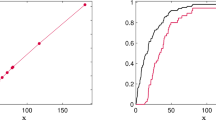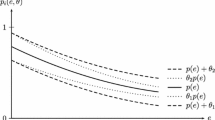Abstract
This article deals with the impact of governmental assistance on insurance demand under ambiguity, i.e., in situations where probabilities are uncertain. First, using a model of insurance demand under ambiguity, we derive theoretical predictions about the impact of several governmental assistance programmes on optimal insurance demand. For example, governmental assistance through a fixed public support scheme implies that partial insurance is always optimal under fair insurance with ambiguity. Second, we present the results of an experiment designed to test these predictions. We find support for several of our theoretical predictions. For example, the presence of governmental assistance through a fixed public support scheme decreases individuals’ willingness to pay to be fully insured. Finally, we compare these results with those obtained for a risk situation. We find that, regardless of the form of governmental assistance, participants in the ambiguity context are consistently willing to pay more to be fully insured than participants in the risk situation.
Similar content being viewed by others
References
Abdellaoui M., Baillon A., Placido L., Wakker P. P. (2010) The rich domain of uncertainty: Source functions and their experimental implementation. American Economic Review 101(2): 695–723
Alary D., Gollier C., Treich N. (2010) The effect of ambiguity aversion on insurance demand. Paper presented at the World Risk and Insurance Economics Congress, Singapore
Browne M. J., Hoyt R. E. (2000) Willingness of homeowners to mitigate climate risk through insurance. Journal of Risk and Uncertainty 20(3): 291–306
Brunette M., Couture S. (2008) Public compensation for windstorm damage reduces incentives for risk management investments. Forest Policy and Economics 10: 491–499
Cabantous L. (2007) Ambiguity aversion in the field of insurance: Insurers’ attitude to imprecise and conflicting probability estimates. Theory and Decision 62(3): 219–240
Cabantous L., Hilton D., Kunreuther H., Michel-Kerjan E. (2011) Is imprecise knowledge better than conflicting expertise? Evidence from insurers’ decisions in the United States. Journal of Risk and Uncertainty 42(3): 211–232
Camerer C., Weber M. (1992) Recent developments in modeling preferences: Uncertainty and ambiguity. Journal of Risk and Uncertainty 5(4): 325–370
Coate S. (1995) Altruism, the Samaritan’s dilemma, and government transfer policy. American Economic Review 85(1): 46–57
Di Mauro C., Maffioletti A. (2004) Attitudes to risk and attitudes to uncertainty: Experimental evidence. Applied Economics 36: P357–372
Eeckhoudt L., Godfroid P., Gollier C. (1997) Willingness to pay, the risk premium and risk aversion. Economic Letters 55: 355–360
Ellsberg D. (1961) Risk, ambiguity, and the Savage axioms. Quarterly Journal of Economics 75(4): 643–669
Gardenförs P., Sahlin N. E. (1982) Unreliable probabilities, risk taking and decision making. Synthese 53: 361–386
Godfroid P. (2000) L’assurance de marché et le consentement à à payer. Revue Economique 51(1): 41–49
Hogarth R., Kunreuther H. (1985) Ambiguity and insurance decisions. The American Economic Review 75(2): 386–390
Hogarth R., Kunreuther H. (1989) Risk, ambiguity, and insurance. Journal of Risk and Uncertainty 2: 5–35
Howel, D. (1997). Méthodes statistiques en sciences humaines. Bruxelles. De Boeck.
Kaplow L. (1991) Incentives and government relief for risk. Journal of Risk and Uncertainty 4: 167–175
Kelly M., Kleffner A. (2003) Optimal loss mitigation and contract design. Journal of Risk and Insurance 70(1): 53–72
Kim M., Schlesinger A. (2005) Adverse selection in an insurance market with government guaranteed subsistence levels. Journal of Risk and Insurance 72(1): 61–75
Klibanoff P., Marinacci M., Mukerji S. (2005) A smooth model of decision making under ambiguity. Econometrica 73(6): 1849
Kunreuther H. (1976) Limited knowledge and insurance protection. Public Policy 24: 227–261
Kunreuther H., Meszaros J., Hogarth R., Spranca M. (1995) Ambiguity and underwriter decision processes. Journal of Economic Behavior & Organization 26(3): 337–352
Lewis T., Nickerson D. (1989) Self-insurance against natural disasters. Journal of Environmental Economics and Management 16: 209–223
Mason C. F., Shogren J. F., Settle C., List J. A. (2005) Investigating risky choices over losses using experimental data. Journal of Risk and Uncertainty 31(2): 187–215
Mossin J. (1968) Aspects of rational insurance purchasing. Journal of Political Economy 76(4): 553–568
Raschky, P., Schwarze, R., Schwindt, M., & Zahn, F. (2010). Uncertainty of Governmental Relief and the Crowding out of Insurance. Working Papers in Economics and Statistics, University of Innsbruck.
Raschky P., Weck-Hanneman H. (2007) Charity hazard—a real hazard to natural disaster insurance?. Environmental Hazards 7: 321–329
Schoemaker P. J. H., Kunreuther H. C. (1979) An experimental study of insurance decisions. Journal of Risk and Insurance 46(4): 603–618
van Asseldonk M. A. P. M., Meuwissen M. P. M., Huirne R. B. M. (2002) Belief in Disaster Relief and the Demand for a Public–Private Insurance Program. Review of Agricultural Economics 24(1): 196–207
Viscusi W. K., Chesson H. (1999) Hopes and fears: The conflicting effects of risk ambiguity. Theory and Decision 47(2): 157–178
Wakker P. (2008) Uncertainty. In: Blume L., Durlauf S. N. (eds) The New Palgrave: A dictionary of economics. The MacMillan Press, London, pp 428–439
Author information
Authors and Affiliations
Corresponding author
Rights and permissions
About this article
Cite this article
Brunette, M., Cabantous, L., Couture, S. et al. The impact of governmental assistance on insurance demand under ambiguity: a theoretical model and an experimental test. Theory Decis 75, 153–174 (2013). https://doi.org/10.1007/s11238-012-9321-8
Published:
Issue Date:
DOI: https://doi.org/10.1007/s11238-012-9321-8




